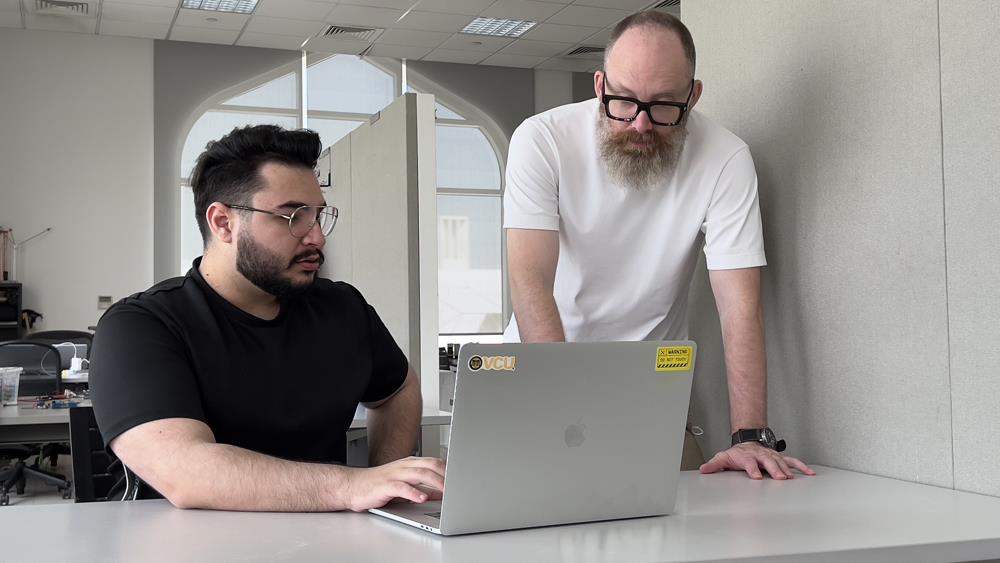
Word 'Breathtaking' Has Different Connotation When Discussing Conflict
Doha:“What's a tangible difference between the living, and the dead?” asks Abdulrahman Alkhatib.“It's a breath; that involuntary, unconscious process of inhalation and exhalation that we all take for granted. Take it away, and a living person becomes a statistic.”
During his third year at Virginia Commonwealth University School of the Arts in Qatar (VCUarts Qatar), Alkhatib, who will graduate with a BFA in Graphic Design this year, wanted to develop a project that would combine design, coding, and yet speak to each viewer, at a personal level.
Thus, was born“A Pixel for Your Soul”.
“The idea behind“A Pixel for Your Soul” came from wanting to transform the number of war casualties in Syria, to something more relatable and human,” explains the Qatar Foundation (QF) partner university student.“But it applies to all people trapped in conflict zones across the world.
“The public tend to lose interest in repetitive information, even if it is about people being killed. While initial reports of killings horrify listeners, soon the dead become data, statistics – 140 deaths, 23 deaths, 57 deaths, 62 deaths. My question was, 'How can I make these numbers relatable?'
“I took two essential characteristics of a living person – a name, and the natural process of breathing – to form the concept. My idea was to show the name of each person who was killed, for a duration of time symbolic of the time it takes for one cycle of breath in a human being.”
Alkhatib discussed the idea with Levi Hammett, an Associate Professor in Graphic Design at VCUarts Qatar. Hammett suggested researching ways of visualising information and choosing the best approach that can build an emotional connection with the audience.
“I decided is to show the names of the people who died in fighting in Syria,” he explains.“Each name would be a pixel, which would be remapped to 4 pixels on screen. The screen gives each name both time and place. Each name would be shown for 8 seconds, 8 seconds being symbolic of the approximate time for one relaxed cycle of inhalation and exhalation in a human being.”
With the help of faculty members, Alkhatib loaded the data set into his laptop, and built a counter that changes the pixels at the 8-second mark. For the typeface, he chose 'Unibody 8-Regular' which responds well to the pixilation.
The project itself evoked memories for Alkhatib. In early 2012, when he was 12 years-old, he, along with his family left Syria for Egypt.
Alkhatib has vivid memories of that time.
“I still remember the day before our flight out of Damascus to Cairo,” he recalls.“We were packing our bags, and I asked my mom if I could take my drawing notebook, pens, pencils, and tools. She told me then that there was no need for that, as our plans were to be back in two months, before the start of our new academic year. I took it anyhow. It's been more than 10 years now. I've filled that drawing book, and many more, not realising then that what was an activity that comforted me, would also lead me to take up graphic design later in life.”
Alkhatib and his family eventually moved to Qatar in 2014, where he attended high school. There, he started to develop his skills in design and art through multiple personal projects. He was part of the 2017 TEDx Aldafna, which he says was a turning point that made him think of studying design in university, and later, as a career. It was a path that eventually led him to VCUarts Qatar.
As he graduates this year, Alkhatib feels that he was fortunate to be able express himself, his people, and his country, through design, in a supportive environment.
“Personally, I think that everyone should have a purpose and cause that he or she fights for,” says Alkhatib.“As a designer, I felt it was my responsibility to support my people and educate the world and the community that I live in about the crimes that are happening back home, and more importantly, raise awareness that those killed in conflict are more than just numbers.”
He adds,“This is the power of design. Design can do what no other field can do: build a connection, awake an emotion, plant an idea, touch minds and hearts, and inspire change. This why I'm proud to be a designer; for me it's a calling. I'm blessed that VCUarts Qatar gave me the opportunity to do this, and I'm glad I'm currently living in a country where design, and designers are respected and celebrated for the value they bring society.”

Legal Disclaimer:
MENAFN provides the
information “as is” without warranty of any kind. We do not accept
any responsibility or liability for the accuracy, content, images,
videos, licenses, completeness, legality, or reliability of the information
contained in this article. If you have any complaints or copyright
issues related to this article, kindly contact the provider above.
Most popular stories
Market Research

- Over US$13 Billion Have Trusted Pendle, Becoming One Of The Largest Defi Protocols On Crypto
- Fitell Corporation Launches Solana (SOL) Digital Asset Treasury With $100M Financing Facility, With Focus On Yield And On-Chain Defi Innovation
- LYS Labs Moves Beyond Data And Aims To Become The Operating System For Automated Global Finance
- Dupoin Reports Global Growth, Regulatory Coverage, And User Experience Insights
- Ethereum Based Meme Coin Pepeto Presale Past $6.7 Million As Exchange Demo Launches
- Solstice Announces Strategic Collaboration With Chainlink And Leading Custody And Venture Firms To Enhance Ecosystem Ahead Of USX Stablecoin Launch



















Comments
No comment